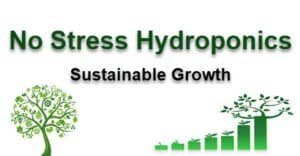Are you looking for an efficient, eco-friendly and rewarding way to grow plants? Hydroponic gardening may be the answer for you. Growing plants without soil can provide surprising results in an efficient environment.
Hydroponics is a type of gardening that doesn’t use soil. Instead, water-soluble nutrients are used to feed the roots of the plants. This method has numerous advantages over traditional gardening, one of which being efficient indoor spaces and short growing seasons.
In order to create a successful hydroponic garden, it is essential to understand how to properly manage the watering process. If not done right your plant’s health will be affected drastically. In this article we will discuss important tips on how to efficiently water your hydroponic plants in order to help them thrive.
Types of Hydroponic Systems:
There are several different types of hydroponic systems. Each system requires a slightly different approach when it comes to watering. The most common types of hydroponic systems are:
1) Deep Water Culture (DWC):
In this method, the plant’s roots are directly suspended in a nutrient-rich solution. The solution is constantly aerated with an air pump to ensure the plants have access to the oxygen they need.
2) Ebb and Flow (Flood & Drain):
This method works by flooding the grow tray with nutrient-rich solution and then draining it away. The plants are briefly flooded every few hours, usually with a timer.
3) Nutrient Film Technique (NFT):
This type of system uses a constantly flowing film of nutrient
When it comes to watering your hydroponic plants, there are a few important considerations to keep in mind. The most important factor is the water temperature. Not only does this affect the absorption rate of nutrients, but also the health of the roots. Ideally, you should aim for a temperature between 65-75 degrees Fahrenheit (18-24 degrees Celsius).
Watering Requirements for Hydroponic Plants:
Another key consideration is the pH level of your water. You should aim for a pH range between 5.5 and 6.5. In order to maintain this, you may need to use a pH adjuster or buffer in your nutrient solution.
Be sure to check the nutrient levels in your water. If they become too low, your plants will suffer from nutrient deficiencies. You can test the levels using a TDS (Total Dissolved Solid) meter.
When watering your hydroponic plants, you should consider the frequency as well. Depending on the type of system and environment in which your plants are located, you may need to water them more or less often. Generally, a good rule of thumb is to check the moisture level of your grow tray daily and water as needed.
Another important factor to consider when watering your plants is the amount of water they need. You should aim to provide enough moisture so that the roots do not dry out, but not so much that they are left sitting in a pool of water. This is especially important in deep water culture systems, as too much standing water can lead to root rot.
Amount of Water to Provide Plants:
The amount of water you provide your plants will vary depending on the type of hydroponic system you are using. In general, you should aim to provide enough moisture so that the roots are kept moist without becoming waterlogged.
In deep water culture systems, it is important to keep an eye on the water level. You should not let the water drop below the roots of the plant, as this can cause the plant to suffer from oxygen deprivation.
In ebb and flow systems, you should aim to fill the grow tray with enough water so that it is just below the base of the plants. This will ensure that they are not left sitting in a pool of standing water, but still get enough moisture for optimal growth.
Finally, in nutrient film technique systems, you should aim to keep the nutrient solution flowing at a steady rate. This will ensure that the roots get enough oxygen and moisture, while also preventing any stagnation of water.
Frequency of Watering Hydroponics Plants:
The frequency of watering your hydroponic plants will also depend on the type of system you are using. In general, deep water culture and ebb and flow systems should be watered every day or two, while nutrient film technique systems should be watered every few hours.
It is important to note that the frequency at which you water your plants will vary depending on environmental factors such as temperature and humidity. In hot, dry conditions, you may need to water your plants more often than in cooler climates.
In addition to the frequency of watering, it is also important to consider the amount of water you are providing your plants. You should aim to provide enough moisture so that the roots do not dry out, but not so much that they are left sitting in a pool of standing water.
Testing the pH Level in the Water Reservoir:
Finally, it is important to test the pH level in your water reservoir. The optimal pH level for hydroponic plants is usually between 5.8 and 6.3. If the pH level in your water reservoir is not within this range, you should adjust it using an acidic or basic solution. It is important to note that different types of plants may require slightly different pH levels, so be sure to check the optimal pH range for your particular plants.
Conclusion
Watering your hydroponic plants is a crucial part of ensuring their optimal growth and health. The amount, frequency, and pH of the water you provide will vary depending on the type of system you are using. It is important to carefully monitor your plants and adjust the amount and frequency of watering as needed.
